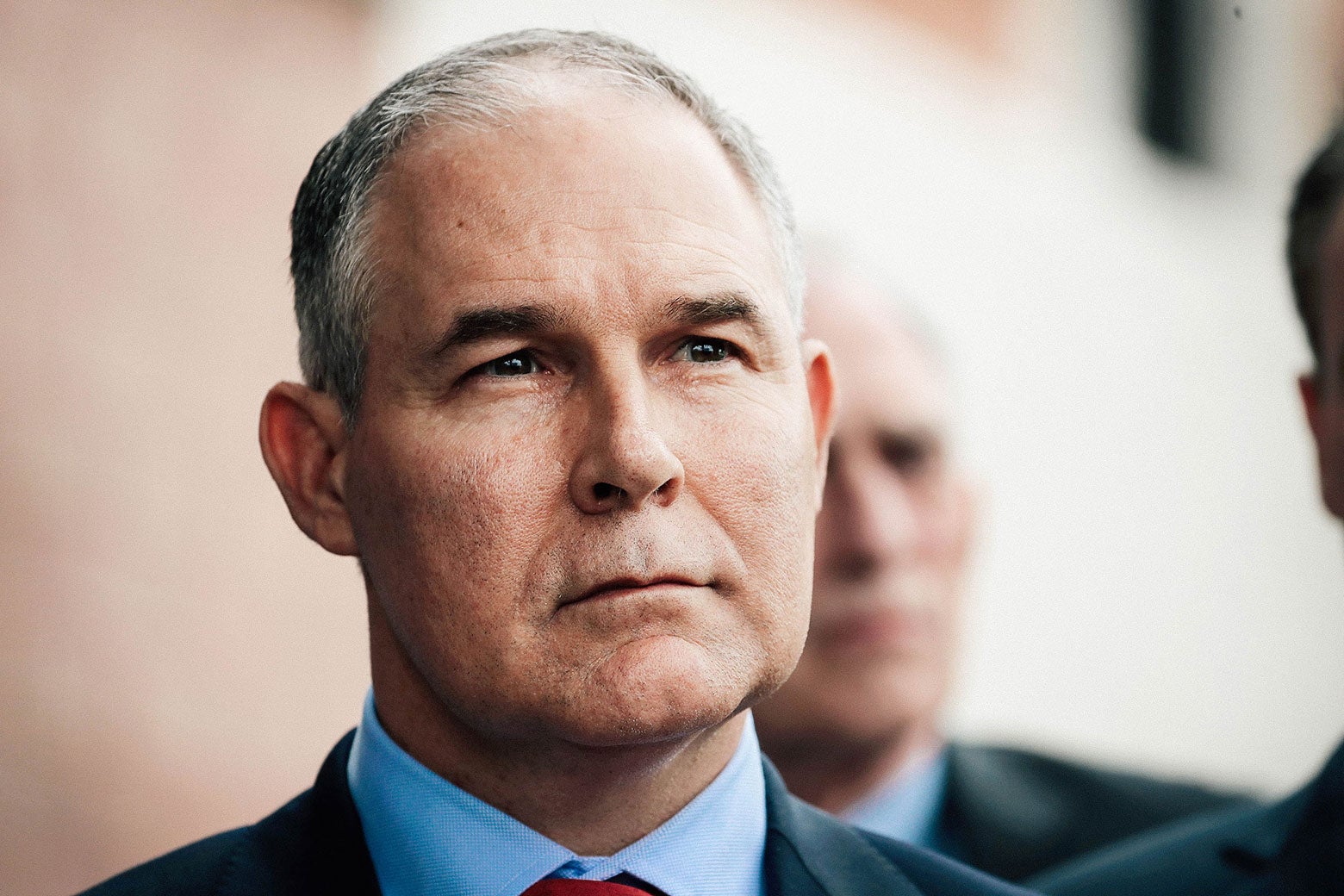Environmental Protection Agency administrator Scott Pruitt’s unending parade of ethical violations keeps grabbing headlines, but his dogged efforts to dismantle environmental safeguards that protect the health and well-being of Americans should concern us the most. Some of these efforts are obvious, like repealing power-plant pollution limits or rolling back vehicle-emissions standards. His most recent move, however, is more insidious.
Last week, Pruitt issued an advance notice of proposed rule-making seeking comments on how the EPA should treat “co-benefits” when assessing the economic impacts of environmental regulation. Co-benefits refer to any positive effects a regulation might have outside of the one directly targeted by the rule. The notice does not telegraph the agency’s position on the question, but Pruitt’s recent statements suggest a predetermined outcome: He’d like the EPA to not have to take them into account. In a speech to the conservative Heritage Foundation, he promised to eliminate the use of co-benefits in the economic analyses accompanying new regulations. And he already took this approach in proposing to repeal the Clean Power Plan, which seeks to limit greenhouse gas emissions from existing power plants.
Rewriting agency guidelines to ignore co-benefits might sound like a mundane accounting change, but over time it would have grave effects on public health and welfare. This change would make it appear that regulations deliver fewer benefits relative to their costs than they in fact would. This would then make it easier for Pruitt to justify repealing rules, further tilting the scales toward the powerful polluters that he insistently favors—while severely disadvantaging the families and communities that bear the heavy burden of pollution.
Pruitt has employed this strategy in the past. It was primarily by ignoring billions of dollars in co-benefits that Pruitt tried to make his proposed repeal of the Clean Power Plan look like a good deal for the American public. That rule was expected to produce not just $20 billion in climate benefits from carbon dioxide reductions, but also an additional $13 billion to $30.3 billion in co-benefits because it would reduce particulate matter pollution: dangerous microscopic solids, or liquid droplets, that are small enough to be inhaled. These particulate-matter reductions were a desirable side effect of the operational changes happening at plants to limit their carbon dioxide output. And the reductions’ beneficial effects on public health—in the form of avoiding thousands of premature deaths annually, as well as fewer heart attacks and asthma hospitalizations—were alone sufficient to justify the Clean Power Plan’s costs. But Pruitt essentially ignored them when making an economic case for repeal. And if Pruitt gets his way going forward, the willful blindness to public health improvements exhibited in the Clean Power Plan analysis will become a standard feature of all EPA rule-making. As my colleague Kimberly Castle and I discuss in a forthcoming article, Pruitt’s approach is inconsistent with scientific evidence, long-standing agency practice under presidents of both parties, and judicial decisions.
As EPA administrator, Pruitt has argued that considering co-benefits was an example of Obama-era overreach—an attempt to “hide the true net cost” of regulating to justify government intervention where it is not needed. But counting co-benefits dates all the way back to President Ronald Reagan, whose EPA took $222 million in yearly co-benefits into account to justify its 1985 regulation reducing lead in gasoline. Moreover, every president since has followed suit by including co-benefits in environmental regulations. Guidelines to federal agencies from the Office of Management and Budget issued during the George W. Bush administration—known as OMB Circular A-4—also instruct agencies, including EPA, to consider co-benefits when deciding whether and how to regulate.
This treatment is appropriate because the EPA has also consistently counted the mirror image of co-benefits: indirect costs.* Several federal courts have required the EPA and other agencies to consider indirect costs as part of the rule-making process. So the result of Pruitt’s efforts would be a permanent tipping of the scales against regulation: a wide range of costs would be considered, while only a narrow range of benefits would be counted.
Policymakers cannot determine whether a regulation is economically justified and beneficial to society if certain benefits are ignored. Left unchecked, Pruitt would dismantle environmental protections while hiding the true impact of his actions. Americans, all of whom depend on clean air and water, would pay with their lives, health, and livelihoods for Pruitt’s misguided deregulatory efforts.
Luckily, when courts review the legality of agency action, they apply the “arbitrary and capricious” standard under the Administrative Procedure Act. It is hard to imagine anything more arbitrary or capricious than taking indirect consequences of regulation into account if they are negative while ignoring them if they are positive. Let’s hope they stop this one.
*Correction, June 13, 2018: Due to an editing error, this article originally misstated that Scott Pruitt had argued in favor of a policy that he had not.
